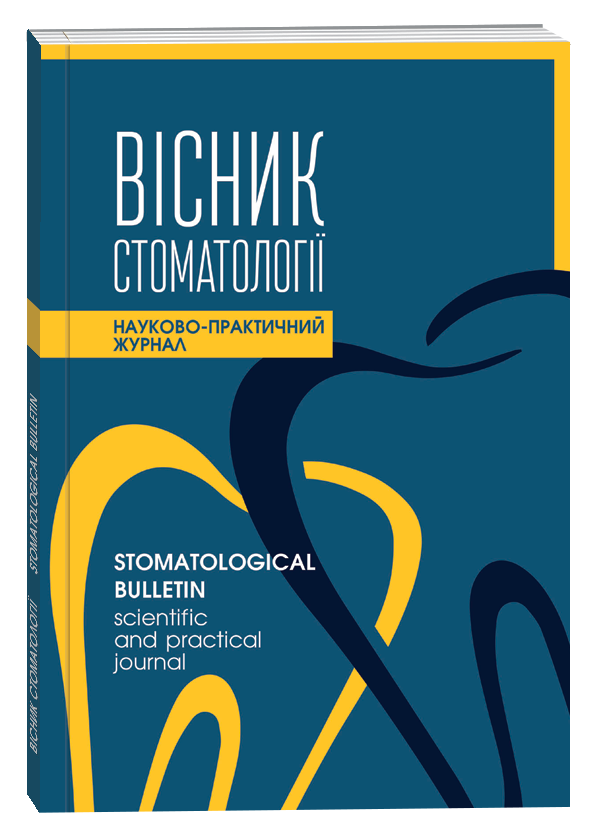CRACKS AND FRACTURES OF TEETH AS A CONSEQUENCE OF THE WRONG CHOICE OF THE METHOD OF TREATMENT OF DEFECTS OF HARD TISSUES OF TEETH
DOI:
https://doi.org/10.35220/2078-8916-2023-47-1.21Keywords:
defects of hard tooth tissues, restoration, complications, tooth cracks, tooth fractures.Abstract
Purpose of the study. To study and analyze the problem of the formation of cracks and fractures of teeth as a result of the wrong choice of the method of treatment of defects of hard tissues of teeth. Research methods. A number of clinical and experimental studies were conducted in accordance with the set goal and established research tasks. The clinical study was aimed at the study and analysis of complications arising after dental treatment of defects of hard tissues of teeth. The experimental study included mechano-mathematical modeling of the contact interaction of the restoration with tooth tissues. The object of the study was the stress-strain state of the "tooth-filling" or "tooth-inlay" composition, taking into account the contact interaction of the hard tissues of the tooth with the filling (inlay). The behavior of a piece-homogeneous elastic composition under the action of a hard stamp, which simulates the behavior of a restored tooth under the action of masticatory load, was investigated. Scientific novelty. On the basis of mechanicalmathematical modeling of the contact interaction of the restoration with the tooth tissues, we established that to ensure strength, the wall thickness of the damaged tooth must satisfy the condition h ≥ 0.175D. With a decrease in the thickness of the crown wall, greater annular stresses occur in the tooth tissues, the rate of growth of annular stresses increases with the increase in the Poisson ratio of the restorative material, and the faster the size of the defect. It is substantiated that large axial stresses that occur in untreated teeth with defects in the hard tissues of the tooth lead to their fractures. The built mechanomathematical model of the contact interaction of the restoration with the hard tissues of the tooth comes true in cases of greater occlusal load perceived by the restoration itself. The larger the volume of the defect, the more sensitive the restored structure is to the physical and mechanical characteristics of the restoration, the more important the choice of material is. It has been proven that the aging of the restorative material leads to an increase in the equivalent stresses in the tooth tissues, reducing the strength of the restoration. Our research allows us to state that errors at the stage of choosing a method of treatment for defects of hard tissues of the teeth lead to clinical situations with an unfavorable prognosis for such teeth up to their loss.
References
Angambakkam R PK, Hagay S, Malli SN. Diagnosis of Vertical Root Fractures by Cone Beam Computed Tomography in Root Filled Teeth with Confirmation by Direct Visualization- A Systematic Review and Meta- Analysis. Journal of Endodontics.2021;47(1). DOI: 10.1016/j.joen.2021.04.022.
Geurtsen W, Schwarze T, Günay H. Diagnosis, therapy, and prevention of the cracked tooth syndrome. See comment in PubMed Commons below Quintessence Int. 2003;(34):409-417.
Suksaphar, W. et al. (2017) ‘Survival rates against fracture of endodontically treated posterior teeth restored with full-coverage crowns or resin composite restorations: a systematic review’, Restorative Dentistry & Endodontics, p. 157. doi: 10.5395/rde.2017.42.3.157.
Бульбук ОВ. Клініко-експериментальне обґрун- тування ортопедичного лікування пацієнтів із дефек- тами твердих тканин зубів [дисертація]. Івано-Фран- ківськ: 2019. 199 с.
Geurdsen W, Schwarze T, Günay H: Diagnosis, therapy and prevention of the cracked tooth syndrome, Quintessence Int 34:409, 2003. 6. Endodontics: Colleagues for Excellence [Internet]. Chicago: AAE; summer 2008. Available from: https://www. aae.org/specialty/wpcontent/uploads /sites/2/2017/07/ ecfesum08.pdf
Wilson N, Lynch CD, Brunton PA, Hickel R, Meyer- Lueckel H, Gurgan S et al. Criteria for the replacement of restorations: Academy of Operative Dentistry European Section. Oper Dent. 2016;41 S7:S48-57. https://doi. org/10.2341/15-058-O
Bulbuk, O., Velychkovych, A., Mazurenko, V., Ropyak, L., Pryhorovska, T. Analytical estimation of tooth strength, restored by direct or indirect restorations. Engineering Solid Mechanics, 7(3), 193-204. DOI: 10.5267/j.esm.2019.5.004
Рожко ММ, Попович ЗБ, Куроєдова ВД. Стома- тологія: підручник : У 2 кн. – Кн. 1. К.: ВСВ «Меди- цина»; 2013. 872 с.
Рожко ММ, редактор. Комплекс алгоритмів для підготовки до атестації випускників за спеціальністю «Стоматологія». Івано-Франківськ: Видавництво ІФНМУ; 2017. С. 264.
Борисенка АВ, редактор. Стоматологічні захво- рювання: терапевтична стоматологія. К.: ВСВ «Меди- цина»; 2017. 664 с.
Біда ОВ, Струк ВІ, Забута ЮІ. Аналіз стану стоматологічного здоровя та рівня зубного про- тезування населення України. Збірник наукових праць співробітників НМАПО ім. П.Л. Шупика. 2013;22(1):370-371.
Германчук СМ, Забуга ЮІ. Результати клінічних досліджень заміщення дефектів коронок зубів ортопе- дичними конструкціями. Вісник проблем біології та медицини. 2012; 2(4):229-231.
Zarow MD, Arcangelo C, Paolone G, Paniz G, Felipe L. EndoProsthodontics – Guidelines for the clinical practice. Chicago: Quintessence Int; 2016.
Shats’kyi ІP, Ropyak Ya, Makoviichuk MV. Strength optimization of a two-layer coating for the par-ticular local loading conditions [Text]. Strength of Materials. 2016;48(5):726–730. doi: 10.1007/ s11223-016-9817-5
Bulbuk O, Bulbuk O, Rozhko M. A New Cavity Classification LOV/DD: An Original Hypothesis. Dent Hypotheses 2020;11:24-7
Pelekhan B, Dutkiewicz M, Shatskyi I, Velychkovych A, Rozhko M, Pelekhan L. Analytical Modeling of the Interaction of a Four Implant-Supported Overdenture with Bone Tissue. Materials. 2022; 15(7):2398. https://doi.org/10.3390/ma15072398









